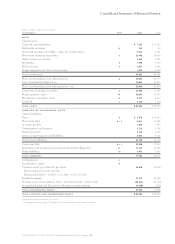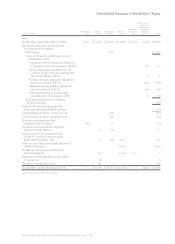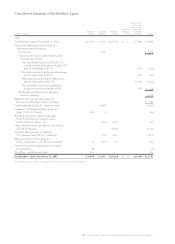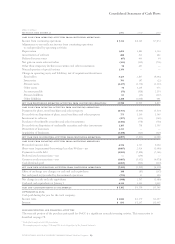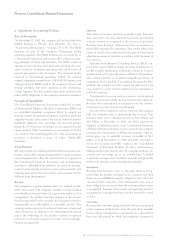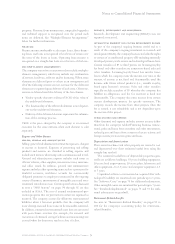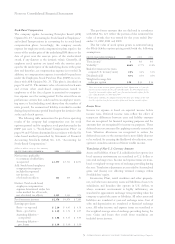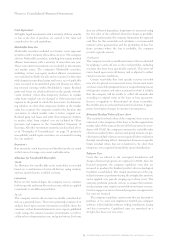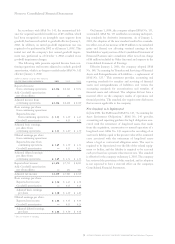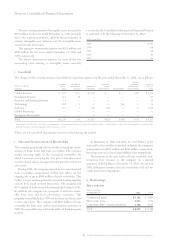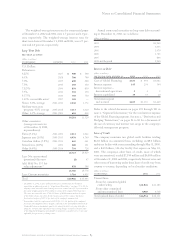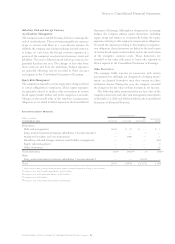IBM 2002 Annual Report Download - page 77
Download and view the complete annual report
Please find page 77 of the 2002 IBM annual report below. You can navigate through the pages in the report by either clicking on the pages listed below, or by using the keyword search tool below to find specific information within the annual report.Notes to Consolidated Financial Statements
75international business machines corporation and Subsidiary Companies
Common Stock
Common stock refers to the $.20 par value capital stock as
designated in the company’s Certificate of Incorporation.
Tr easury stock is accounted for using the cost method. When
treasury stock is reissued, the value is computed and recorded
using a weighted-average basis.
Product Warranties
The company estimates its warranty costs based on historical
warranty claim experience and applies this estimate to the
revenue stream for products under warranty. Included in the
company’s warranty accrual are costs for limited warranties
and extended warranty coverage. Future costs for warranties
applicable to revenue recognized in the current period are
charged to cost of revenue. The warranty accrual is reviewed
quarterly to verify that it properly reflects the remaining obli-
gation based on the anticipated expenditures over the balance
of the obligation period. Adjustments are made when actual
warranty claim experience differs from estimates.
Earnings Per Share of Common Stock
Earnings per share of common stock
—
basic is computed by
dividing Net income applicable to common stockholders by the
weighted-average number of common shares outstanding for
the period. Earnings per share of common stock
—
assuming
dilution reflects the maximum potential dilution that could
occur if securities or other contracts to issue common stock
were exercised or converted into common stock and would
then share in the net income of the company. See note t,
“Earnings Per Share of Common Stock,” on page 93 for
additional information.
bAccounting Changes
Standards Implemented
In April 2002, the Financial Accounting Standards Board
(FASB) issued SFAS No. 145, “Rescission of FASB Statements
No. 4, 44 and 64, Amendment of FASB Statement No. 13, and
Technical Corrections,” effective May 15, 2002. SFAS No. 145
eliminates the requirement that gains and losses from the
extinguishment of debt be aggregated and classified as an
extraordinary item, net of tax, and makes certain other tech-
nical corrections. SFAS No. 145 did not have a material effect
on the company’s Consolidated Financial Statements.
Effective January 1, 2002, the company adopted State-
ment of Financial Position (“SOP”) 01-6, “Accounting by
Certain Entities (including entities with Trade Receivables)
That Lend to or Finance the Activities of Others.” With
limited exception, SOP 01-6 applies to any entity that lends
to or finances the activities of, others and provides specialized
guidance for certain transactions specific to financial institu-
tions. This SOP reconciles and conforms, as appropriate, the
accounting and financial reporting guidance established by
the American Institute of Certified Public Accountants. The
adoption did not have a material effect on the company’s
Consolidated Financial Statements.
In October 2001, the FASB issued SFAS No. 144, “Account-
ing for the Impairment or Disposal of Long-Lived Assets.”
SFAS No. 144 addresses significant issues relating to the imple-
mentation of SFAS No. 121, “Accounting for the Impairment
of Long-Lived Assets and for Long-Lived Assets to Be
Disposed Of,” and develops a single accounting model, based
on the framework established in SFAS No. 121 for long-lived
assets to be disposed of by sale, whether such assets are or are
not deemed to be a business. SFAS No. 144 also modifies the
accounting and disclosure rules for discontinued operations.
The standard was adopted on January 1, 2002, and did not have
a material impact on the company’s Consolidated Financial
Statements. The discontinued HDD operations are presented
in the Consolidated Financial Statements in accordance with
the new SFAS No. 144 rules.
In November 2001, the FASB issued Emerging Issues
Task Force (EITF) Issue No. 01-14, “Income Statement
Characterization of Reimbursements Received for ‘Out of
Pocket’ Expenses Incurred.” This guidance requires compa-
nies to recognize the recovery of reimbursable expenses such
as travel costs on services contracts as revenue. These costs
are not to be netted as a reduction of cost. This guidance was
effective January 1, 2002. This guidance did not have a mate-
rial effect on the company’s Consolidated Financial Statements
due to the company’s billing practices. For instance, outside
the United States, almost all of the company’s contracts
involve fixed billings that are designed to recover all costs,
including out-of-pocket costs. Therefore, the “reimbursement”
of these costs is already recorded in revenue.
In July 2001, the FASB issued SFAS No. 141, “Business
Combinations,” and SFAS No. 142, “Goodwill and Other
Intangible Assets.” SFAS No. 141 requires the use of the pur-
chase method of accounting for business combinations and
prohibits the use of the pooling of interests method. Under
the previous rules, the company used the purchase method of
accounting. SFAS No. 141 also refines the definition of intan-
gible assets acquired in a purchase business combination. As a
result, the purchase price allocation of current business com-
binations may be different than the allocation that would have
resulted under the old rules. Business combinations must be
accounted for using SFAS No. 141 effective July 1, 2001.
SFAS No. 142 eliminates the amortization of goodwill,
requires annual impairment testing of goodwill and intro-
duces the concept of indefinite life intangible assets. The
company adopted SFAS No. 142 on January 1, 2002. The new
rules also prohibit the amortization of goodwill associated
with business combinations that closed after June 30, 2001.


